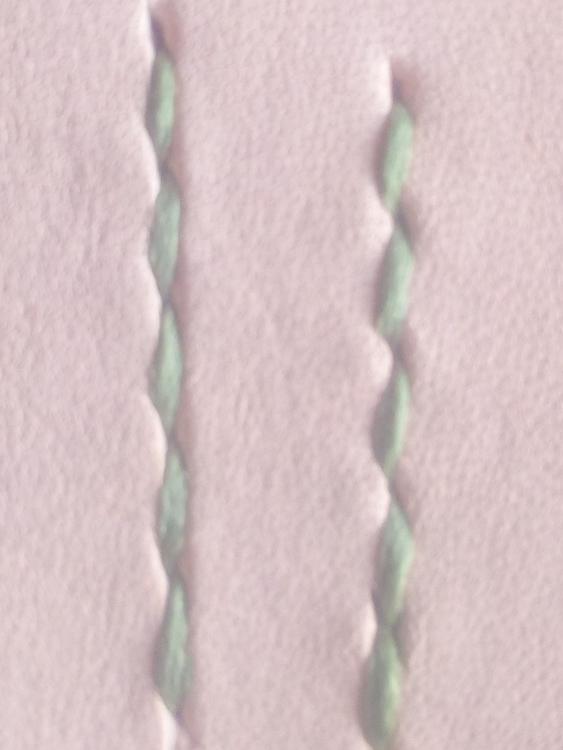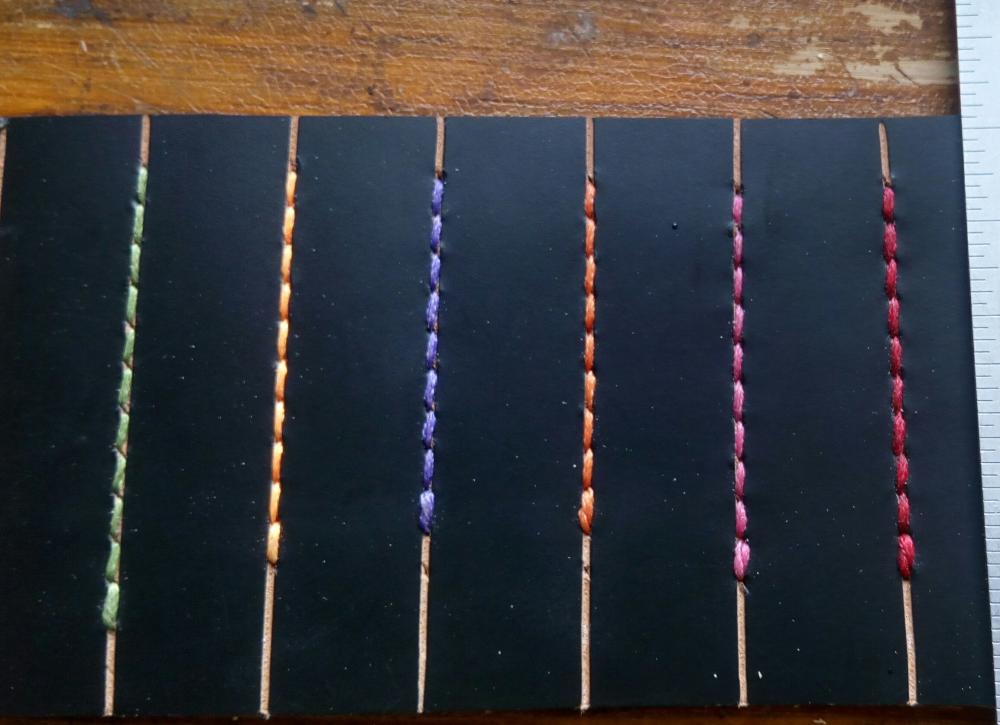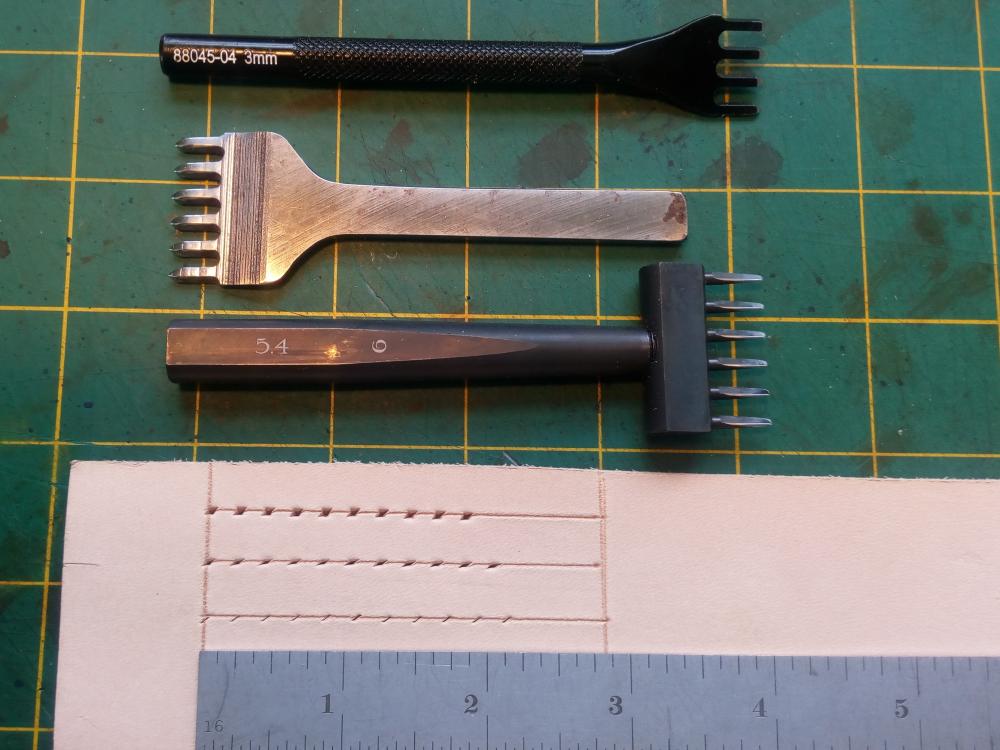
mike02130
Members-
Posts
512 -
Joined
-
Last visited
Content Type
Profiles
Forums
Events
Blogs
Gallery
Everything posted by mike02130
-
old controversy Hand Made /Sewing Leather
mike02130 replied to spurdude101's topic in Leatherwork Conversation
Skill and handmade are two different things. -
Thanks to you two for replying. I figured on just going and buying a piece of plexi but thought I’d take a chance here first.
-
Hello, I’m interested in a cutting mat for use with a head and Japanese knife. When using my green mat the blade cuts into the mat resulting in drag. Especially when cutting curves. I’ve read a couple posts saying that green mats shouldn’t be used. I’ve tried white cutting boards and they cause the same problem. I notice on YouTube that a lot of leather workers from Korea, China and Japan use some type of acrylic or plexiglass to cut on. Does anyone know what material they use? Does anyone have another recommendation? Thanks, Mike
-
Make your own. One doesn’t need much know-how. Three pieces of 1”x4” wood, a hinge, few screws and a bolt. Lumber yard can cut for you.
-
You will never know unless you try it. You will never know unless you try it.
-
I recently bought that exact square. I really like it for squaring up straps and handles.
- 13 replies
-
- mini square
- square
-
(and 2 more)
Tagged with:
-
To get back to Rasmus' question. Pfeil Swiss Made tools makes a head knife. I don't know anything about them. I have some of their older carving tools which I think are better than their newer ones. They're in Europe.
-
Modern super steels are harder and will hold an edge longer, thus making it more difficult to sharpen. It does have a high carbon content but it also has a lot of chromium which makes it hold an edge longer, which also makes it more difficult to sharpen. It will wear down natural sharpening and waterstones much faster than carbon. Also, because of it's hardness it is prone to chipping. Carbon steel is softer, takes a better edge--some may argue--and has a tighter grain structure. Once a steel like D2 starts going dull it takes work to bring it back. It is also semi stainless. Where as carbon is much easier and forgiving when stropping or honing. It is also prone to rusting. The best chef's knives, axes and woodworking and carving tools are carbon. Now days many people don't know how to sharpen or take care of carbon steel tools. They want a sharp tool that stays sharp. I would choose 1095 steel over D2 anytime. The best chef's knives are made of carbon steel; Japanese, Sabatier, pre stainless American and the like. Straight razors are carbon. Personally I feel a lot of leather knives' steel are more of a gimmick and selling point. Most knives I think are way over priced. Knife makers like to tout how hard and sharp and how long their knives will hold an edge but not many tell you the difficulty of maintaining an edge. At least not beyond stropping.
-
I don't think you can go wrong with American made tools by small makers. Guys like Barry King, Ron's tools and Jeremiah Watt's Horse Shoe brand. Weaver leather supply has some nice tools. If you're a beginner you may want to wait on a head knife. It's more for the advanced. But if you really want one, I would recommend an older Osborne from Ebay. There are also some good Japanese and South Korean tools available.
-
I have a set of 3.85 mm that I think are great. The teeth line-up well on a stitching line and they are quite comfortable to use. Eventually I will buy another set. The teeth are tapered so the width of the hole will vary by how far you punch though. With the 3.85 mm ones I do notice that when using .6 mm tiger thread that I often need to use an awl to open up the hole on the good side of the leather. In other words, when I put the first needle through the backside and pull it out of the hole, the knot sometimes sticks. I need to give it a good tug and sometimes this results in a slight blow out on the good side. Most noticeable when I'm using leather which I've dyed myself. A piece of small undyed tear out results. I only use 4 to 8 ounce veg tanned leather. When using thinner thread there is no need for tugging or using an awl. The Sinabroks look interesting. I believe the teeth are straight rather than tapered. I would guess that they may not result in the knot sticking and may eliminate the need for an awl.
-
Glove Snaps vs Segma Snaps
mike02130 replied to SalesZackWhiteLeather's topic in Hardware and Accessories
Rocky Mountain Leather in USA carries them. They sell and ships internationally. https://www.rmleathersupply.com/- 4 replies
-
- belt snaps
- glove snaps
-
(and 1 more)
Tagged with:
-
Anyone ever ordered from Leather Unlimited?
mike02130 replied to Hilly's topic in Leatherwork Conversation
I learned the hard way. I should've read the reviews first. I bought a side of veg tanned leather. It was, with out any exaggeration, the worse piece of leather I ever purchased. They called it their "A Grade". Full of holes, tears and insect bights. It was folded in half then rolled up, leaving a crease in the middle.I was behind on a project and used some out of desperation. I figured maybe I could cut out small usable pieces for straps, gussets and the like. No, I was grossly mistaken. I would examine the leather and cut out a pattern from what looked OK but when I died it, all kinds of scarring and other defects appeared.How do these guys sleep at night? It would be one thing if they were honest and advertised that they're leather was crap, but to call it "A-Grade" is deceptive and just plain wrong. -
Yeah sure, the outside spins faster than at the shaft. This is a 1.75" leather burnisher we're talking about, not a large wheel. The person only has a few options at speed choices. No one has presented an optimum speed. So sitting down and figuring out ratios would be a mute point. Get the burnisher on a machine and see if it works. If the Cobra machine works well at two thousand rpms(I'm assuming that speed is measured at the shaft) and burns the leather at 3000 then one would go to 2000 rpms or less. A 1725rpm motor should be fine. I used one at 180 rpms and that worked well. I'm sure there are other solutions, but no one has offered any
-
I just bought one similar to yours--maybe the same?. I asked the maker what speed is good. I gave him a list of speed options from 180rpms to 3500. He told me slower is better. I tried it on some 9 oz veg tan at 180 rpms and that worked well. But I haven't had the chance to try other rpms--yet. Don't let anyone get you caught up in figuring rpms to diameter ratios and the like. If you want to go simple you can pick up a used 1/4 to 1/2 HP motor with 1725 or 3500 rpms pretty cheap. Buy an arbor and chuck and you have a good machine. This set up has a much smaller footprint than a drill press. Hell, get a double shaft motor, two chucks one with a drum sander the other with the burnisher.
-
If it gets cold or damp you may want to place some ridgid insulation between the dirt and the bottom of the floor joists. Cheap and easy.
-
Hey all. I'm interested in seeing some up close detail pictures focusing on the cutting edge of Barry King's and Jeremiah Watt's horse shoe brand french edgers. I'm showing a #5 from Ron's tools. I'd like to see a comparison. Thanks. Mike Oops, I can't upload a pic bigger than 1.46 mb. I'll see if I can figure it out.
-
- french edger
- rons tools
-
(and 2 more)
Tagged with:
-
Thanks DJole for the tip. I'll give it a try.
-
I'm probably a day late and a dollar short, but I'm interested in the single.
- 12 replies
-
- ks blade
- pricking iron
-
(and 1 more)
Tagged with:
-
Made a stitching awl and... ruined it with linseed oil
mike02130 replied to DrmCa's topic in Leather Tools
If BLO is put on too thick or not wiped off soon enough it has a tendency to not dry and be sticky. It will eventually dry but will have a rough texture. It is best to thin it down and apply two coats and wipe it down immediately. I use my bare hand to rub it in. I'm of the belief that the heat from the friction opens the pores of the wood allowing deeper penetration. Rub on rub off and it is ready to use. There is no need to let it dry like a paint or varnish. Try it out and let us know if it works or not. Just a thought, if it is too thick it may polymerize from the outside in, thus cutting off the oxygen to the inside. -
Tugadude, Thanks for the response and example. I made a sample with and without a groove and the line without the groove looks much better. The angles are more pronounced and the thread has more dimension and not flat as when it's laying in the groove. Two more questions, please. I see the advantage of not grooving but when should one groove? One advantage I see for the groove is that it creates a line for the stitching chisel to register. Does one use a compass to scribe a light line as a guide? Thanks again.
-
Thanks much guys. Most of my work has been tool covers and sheaths for woodworking and carving tools and axes and the like. Six to eight ounce leather plus a welt making it tripled up. I use a groover and 1mm thread. It looks good to me and maybe a little chunky. But with nothing to compare it to, I don't know. Here are some samples on a 4/5 ounce single piece of leather. I like the look of a contrasting thread. Is that considered chunky? The first three are skinny 1mm Chinese thread, the next two are 1mm Tiger thread. Tugadude, you said, "I suggest you try 0.6mm Tiger thread. It is readily available in your country." I'm in your country, New England, vs Jolly Old England. Thanks
-
I've been working leather for about six months. All my learning is from YouTube, books and trial and error. I think I may be to the point where my stupid questions may be formulated as not to be as stupid as they wouldve been six months ago. My questions and thoughts concern stitching irons/chisels, the ones that are multi tined and are used to punch holes through leather to sew without useing an awl. 1, My first tool was a Craftool brand 3 mm 4 prong. I wanted more of an assortment--and not caring for the Craftool--I bought a set of four Aiskaer White Steel 4mm Diamond Lacing Stitching Chisels for 12 bucks. When the two brands are placed point to point the tines are identically spaced. What gives? I wonder if the Chinese Aiskers are wrongly described and are actually 3mm? How are these measured and are there different methods of measuring? Most seem to be sold stating the size in millimeters. I see a few brands that state the stitches per inch (SPI) which seems to make more sense to me. 2, Does one match the chisel or thread to the thickness of leather or to the amount of desired spacing between stitches, or, to the thickness of thread? I would think the thinner the leather the closer the spacing and thinner the thread and hole? 3, European vs American. I often hear folks referring to American style as being bulky. From what I gather they mean that useing a stitching iron results in a bigger hole than a pricking iron and awl? 4, I watched some of Nigel's videos and bought a couple of KS Blades pricking irons. Not having the experience or knowledge of the tools I really don't know what I have or how or when to use them. I've used them a few times but the tool make such a narrow slit that I often need to use an awl to open it up. Maybe it's because of my lack of experience but I don't care for them. Are the KS tools for thinner thread or leather? How, why and when should they be used? 5, I usually use 4-8 ounce leather and 1mm thread and an appropriate sized needle. I would like to start making hand bags and wallets using thinner leather. What size hole making tool and thread is recommended? Here is an example of the Craft Tool, Aiskaer and KS Blades. I prefer the middle line made by the Aisker. Like Goldilocks picking the bed not too soft not too hard. Thank you very much.

.jpg.d60258221c476480a6e073a8805645bb.jpg)


